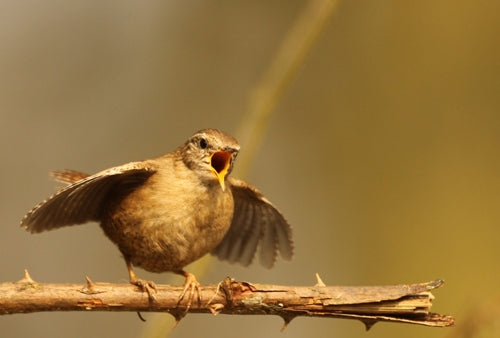Have you ever strolled through the countryside wondering what bird you just heard? Or what the different tweets and chirrups of UK songbirds actually mean?
For many, birdsong is simply the white noise that accompanies being out of doors. But for me these avian calls are like the daily broadcast; they tell me what’s happening and where. I’m constantly tuned into bird chatter and if I hear a noise out of place, I stand stock still and wait until a predator emerges, slinking from the shadows. Over the years I have become so attuned to birds that I can tell the separate voices of different birds - even during the clamour of the dawn chorus, when all the birds sing out at once to herald the arrival of spring. In fact I like to sleep with the window open so that every morning when all the birds are in full throat I can test myself by working out which bird is out there tweeting and what they are saying to one another.
Birds have surprisingly complex vocabularies. Blackbirds, for example, are very precise. They make differently-pitched alarm calls to warn one another of imminent danger. Their low-toned note means a ground
predator, like a fox, their high pitched shrill says the hunter is airborne, perhaps a sparrowhawk. When I’m out in a hide, it’s the birds that tell me to get my camera ready. The ability to understand the meaning of birdsong is becoming a lost art. But it’s a skill that is well-worth learning.
predator, like a fox, their high pitched shrill says the hunter is airborne, perhaps a sparrowhawk. When I’m out in a hide, it’s the birds that tell me to get my camera ready. The ability to understand the meaning of birdsong is becoming a lost art. But it’s a skill that is well-worth learning.
Start by learning the signature tunes
Among the UK’s native species there are definite ‘songsters’. These are birds with beautiful voices, like blackbirds, robins, skylarks, song thrushes and chaffinches, and each has its own, distinct signature tune. Once you’ve learned a bird’s jingle, you can always pick it out, even if it only sings a few phrases of the melody. Although these songs sound joyful, they are actually expressions of aggression used to warn off competitors or noisy serenades to attract a mate.
 |
| Robin, by Robert E Fuller |
Build on what you know
Most of us already have a basic knowledge of birdsong. Without even realising it, even the most unversed in nature know the hoot of a tawny owl or a cuckoo’s call. It’s not difficult to add to this the ‘Repeat, repeat’, ‘repeat’ of a song thrush or the incessant, noisy chitter of a wren. For such a tiny bird, a wren’s ditty is particularly loud. I’ve painted this characterful bird many times and I like to depict it with its beak open in noisy song.
Fit the sound to your surroundings
If you are by a river or a stream, for instance, and you hear a loud, piping call then look out for the electric-blue of a kingfisher as it flashes past. Similarly grey wagtails make a sort of ‘chiswick’ call that is
so loud you can hear it above the sound of crashing water. These beautiful birds have lemon-yellow bellies, despite their name.
so loud you can hear it above the sound of crashing water. These beautiful birds have lemon-yellow bellies, despite their name.
 |
| A Splash of Colour, painted by Robert E Fuller |
Listen for birds that 'say' their own names
Cuckoos, curlews, kittiwakes and chiffchaffs are named after the calls they make. Listen out for the ‘chiff’ ‘chaff’ of a chiffchaff next time you are walking through scrubland or woodland.
If you are by the sea, a kittiwake will say its name to you ‘kitty-waake’ ‘kitty-waake’ as it soars over precipitous coastal cliffs.
Add lyrics to a melody to help you remember it
Some bird songs sound like nursery rhymes. A yellow hammer is said to be saying: “A little bit of butter and nooo cheeese”. Once you’ve got lyrics in your head it’s easier to remember the tune.
Beware of mimics
Things get tricky when you get one bird mimicking another. Only the very best songsters can do this and the trick is part of a male’s noisy strategies to impress a mate. I recently heard a starling impersonating a
curlew. Only the chatter of ‘starling’ that it emitted shortly before and afterwards gave the game away.
curlew. Only the chatter of ‘starling’ that it emitted shortly before and afterwards gave the game away.


















